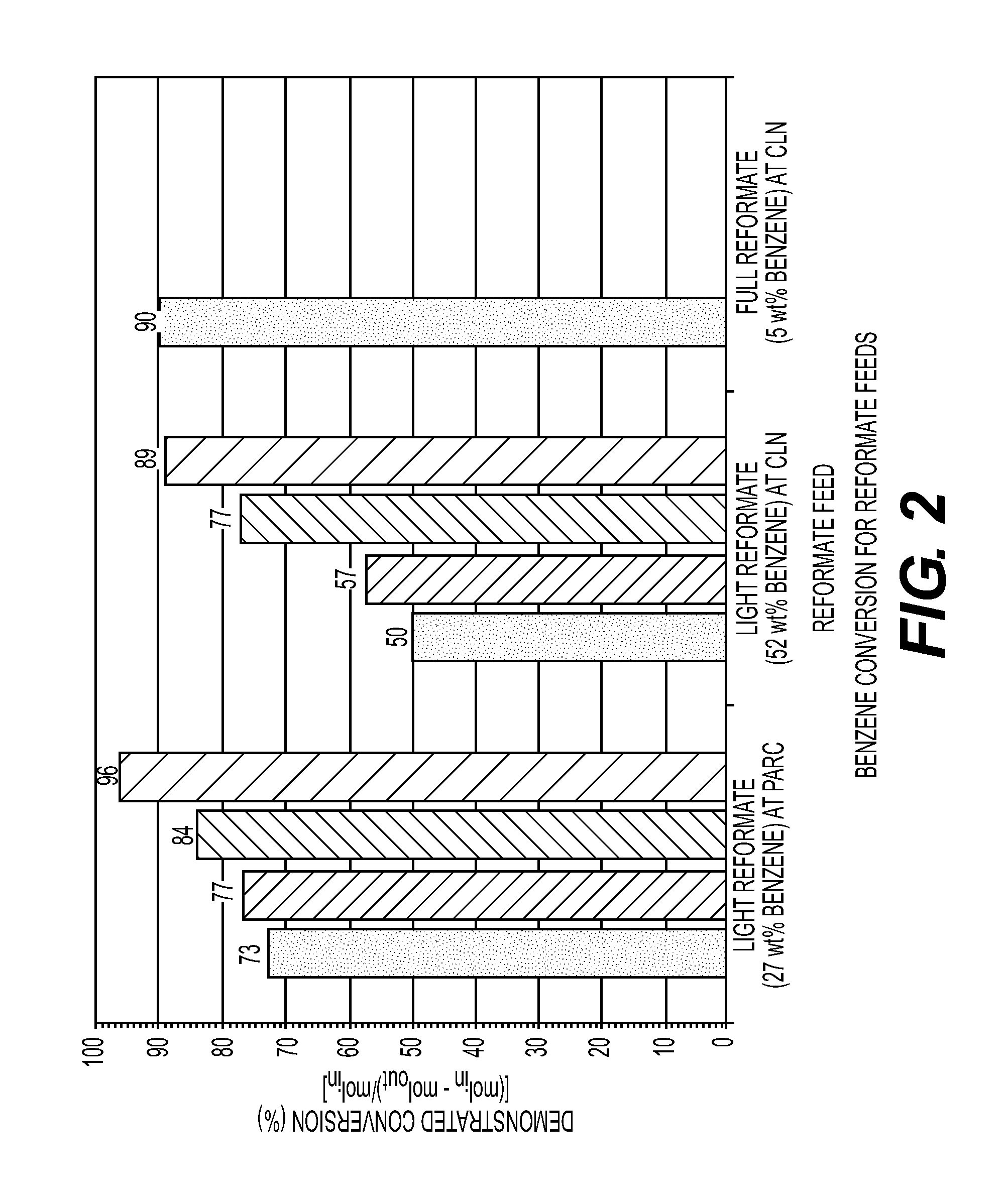Process for making high octane gasoline with reduced benzene content by benzene alkylation at high benzene conversion
a technology of benzene alkylation and high octane, which is applied in the direction of hydrocarbon oil treatment products, physical/chemical process catalysts, bulk chemical production, etc., can solve the problems of insufficient benzene reduction solutions that worked with rfg to meet the new specifications, compliance issues, and difficulty in providing gasoline for the us market by foreign suppliers, etc., to achieve high octane rating, high benzene conversion levels, and favorable boiling rang
- Summary
- Abstract
- Description
- Claims
- Application Information
AI Technical Summary
Benefits of technology
Problems solved by technology
Method used
Image
Examples
examples 1-3
[0071]Three reformate samples were alkylated with a propylene stream. The reformate streams were a light cut with 27 wt. % benzene, a light cut with 52 wt. % benzene and a full range reformate with only 5 wt. % benzene. Their compositions are set out in Tables below. The propylene stream was a petrochemical grade stream of 99 wt. pct. propylene and 1 wt. pct. propane.
[0072]The alkylation was carried out in a pilot plant under the conditions described below using a catalyst of MCM-49 (80 / 20 zeolite / alumina) 1.27 mm (0.05 inch) quadrulobe. This same type of catalyst was also used in all the Examples below. A range of benzene conversions were achieved with the different reformate feeds.
[0073]Table 8 shows the operating conditions for pilot unit studies with the three different reformate feeds. All studies were operated in once-through mode with an inlet temperature of 205 C (400° F.) and 6550−7000 kPag (950-1000 psig) reactor pressure. These pilot units were set up with one propylene i...
examples 4-5
[0077]The advantages of using interstage olefin injection were demonstrated using pilot plant units with one reactor with one olefin injection or three reactors with three olefin injection points, one before each reactor with the reformate flowing through the reactors in series.
[0078]The pilot unit operated with the liquid phase, single pass conditions shown in Table 10, using a constant aromatic:olefin ratio of 0.72:
TABLE 10Unit Operating ConditionsT inlet, ° C.(° F.) 204 (400)Pressure, kPag (psig)4140 (600)Reformate WHSV2.7FeedBenzene (wt %)24.9Toluene (wt %)4.9BalanceSulfolane RaffinateAromatic:Olefin Ratio0.72
[0079]FIG. 5 shows the improvement in conversion with three olefin injection points compared to a single injection configuration. While the overall propylene feed rate is kept constant between the two configurations, the three olefin injection configuration shows an improvement in benzene conversion at the same aromatic to propylene molar ratio (A:P). The Simulated Distilla...
examples 6-11
[0082]These Examples show that alkylation of the reformate provides an increased octane value for the product. Pilot unit studies have demonstrated a positive octane delta, the magnitude of which depends on benzene conversion and product cut point. The pilot unit, from which the data was presented from, is in a once through, single olefin injection configuration. The unit was running according to the following Table 11.
TABLE 10Unit Operating ConditionsUnit ConditionsT inlet, C. (F.)204 (400)Pressure, kPag (psig)7,000 (1,000)Reformate WHSV2.7FeedBenzene (wt %)24.9 Toluene4.9BalanceSulfolane Raffinate
[0083]The data in Table 12 below show octane data recorded in the pilot plant. All octane analyses were conducted by engine tests via D 2699 and ASTM D 2700. The results show that the magnitude of the increase in octane (both RON and MON) is dependent on the benzene conversion; the sensitivity, however, increases slightly with conversion.
TABLE 12Reformate Octane Increase with Alkylation(R...
PUM
| Property | Measurement | Unit |
|---|---|---|
| weight percent | aaaaa | aaaaa |
| weight percent | aaaaa | aaaaa |
| weight percent | aaaaa | aaaaa |
Abstract
Description
Claims
Application Information
 Login to View More
Login to View More - R&D
- Intellectual Property
- Life Sciences
- Materials
- Tech Scout
- Unparalleled Data Quality
- Higher Quality Content
- 60% Fewer Hallucinations
Browse by: Latest US Patents, China's latest patents, Technical Efficacy Thesaurus, Application Domain, Technology Topic, Popular Technical Reports.
© 2025 PatSnap. All rights reserved.Legal|Privacy policy|Modern Slavery Act Transparency Statement|Sitemap|About US| Contact US: help@patsnap.com



